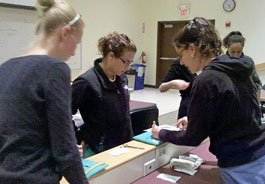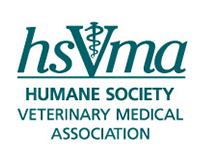HSVMA Hosts Suture Lab at TuftsDecember 13, 2010 The Tufts University Chapter of the Humane Society Veterinary Medical Association recently held a humane suture lab on the school's campus. Participating students were given substantial one-on-one time with the three instructors present and came away with a thorough understanding of the simple continuous suture pattern, as well as the Surgeon’s and Miller’s knot ligatures.  Tufts veterinary students receive one-on-one instruction at the suture lab. HSVMA Morgan Peterman, DVM, HSVMA Field Services Field Director, spent the first hour discussing surgical teaching alternatives, such as willed body donation programs, “phantom” models for practicing sutures, and the HSVMA Field Services program, a hands-on training opportunity that Tufts students routinely participate in. She challenged students to advocate for more humane teaching tools, which are readily available and can provide a superior learning experience over traditional methods, simply because the potential limitations of working on a living patient—such as fears about harming the patient and the inability to repeat a given step until mastered—are not a concern with models. “While the Tufts Anatomy Department already has a willed body program in place, I was really excited to hear about all of the ‘Rescue Critters’ models available for practicing various procedures, like endotracheal tube placement and now, surgical spay and neuter,” noted Aimee Vasse, a second-year student at Tufts and co-president of the HSVMA. “I am hopeful that Tufts will consider employing some of these models,” she added. During the second hour, the students watched video demonstrations of the suture and ligature patterns and practiced the techniques on huck towel models, with a piece of rubber tubing for ligatures. “The point is to establish muscle memory,” Dr. Peterman explained. “Nothing feels exactly like real tissue.” At the conclusion of the lab, students were given models to take home. Dr. Peterman emphasized the importance of regular practice, stating, “Suturing and ligatures apply to almost every single procedure,” and improvement in this area is not only the “easiest way to improve surgical time,” but also can “determine the morbidity and mortality of your patient.” HSVMA offers these suture labs as a benefit to its student chapters. To learn more about HSVMA student chapters, visit hsvma.org/students and/or contact us at [email protected]. |
